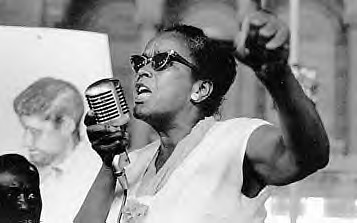
Mrs. Ella Josephine Baker (1903-1986) speaks in Mississippi during the aftermath of the murder of three civil rights workers during the summer of 1964. She was a leading force in the Freedom Democratic Party., a photo by Pan-African News Wire File Photos on Flickr.
Down in North Carolina: The Birth of SNCC
Published Jul 1, 2012 10:20 PM
By Durham Branch Workers World Party
North Carolina has a strong activist legacy for human and Civil Rights — from the Wilmington 10 to current-day DREAM activists. North Carolina has been a central locale in the South for organizing against racist oppression, especially during reconstruction and later during the Civil Rights movement.
The Student Nonviolent Coordinating Committee (SNCC) is a part of North Carolina’s rich history of activism, and its birth in 1960 is a testament to what students, activists and everyday folks can achieve when they band together to fight the racist powers that be.
In the Jim Crow South throughout the first half of the 20th century, Black people were fighting the racist and oppressive system of segregation that kept Black people isolated and economically deprived. All across the southern United States Blacks and whites, working in solidarity, were taking part in harrowing direct actions and confronting the oppressive status quo.
From sit-ins to boycotts to protests, it was clear there was a movement afoot, and North Carolina and its activists would prove to be an essential piece of the equation.
Sit-ins, like the much-famed Woolworth sit-in in Greensboro in 1960, inspired many and galvanized a broader movement across the South. The Southern Christian Leadership Coalition, the NAACP and countless other organizations proliferated throughout the South, creating a broad network of organizers.
Among those active in the struggle was Ella Baker, an alumna of Shaw University in Raleigh and a committed activist.
Baker was instrumental in the creation of the Southwide Youth Leadership Conference at her alma mater. The conference, held over the Easter holiday of 1960, proved to be both powerful and productive. SNCC was born out of the conference and within it were two very powerful contingents: a wing devoted to direct action and a wing devoted to voter registration and the enfranchisement of hundreds of thousands of Black people across the United States.
SNCC sought to differentiate itself from the SCLC and the NAACP, and it did. SNCC was the vanguard within the southern Civil Rights movement, taking on greater risks than many other organizations. Freedom riders risked life and limb, entering the most dangerous pro-Jim Crow Deep South, fighting segregation and confronting violent opposition at the hands of racist police, FBI and residents.
By the mid-1960s, SNCC was not only combating oppression on the front lines in public spaces, but also organizing labor unions and political parties to fight the racist Southern Democratic or Dixiecrat machine. These activities further strengthened organizing in the South and paved the way for different factions of the group to go on to fight important battles there.
North Carolina’s legacy extends well beyond its borders. SNCC is a powerful example of what can be accomplished on a national level when activists unite to combat injustice, inequity and racial oppression! We walk in the footsteps of those who fought to gain so much, and it is our duty to continue to fight all oppression and band together in solidarity!
This is the first of a series of historical articles focusing on North Carolina and organizing in the South, in anticipation of the demonstration at Wall Street South — in Charlotte — during the Democratic National Convention.
-----------------------------------------------------
Articles copyright 1995-2012 Workers World. Verbatim copying and distribution of this entire article is permitted in any medium without royalty provided this notice is preserved.
Workers World, 55 W. 17 St., NY, NY 10011
Email: ww@workers.org
Subscribe wwnews-subscribe@workersworld.net
Support independent news DONATE
No comments:
Post a Comment